
Destinations of Interest
CITY OF SAN FRANCISCO OF QUITO
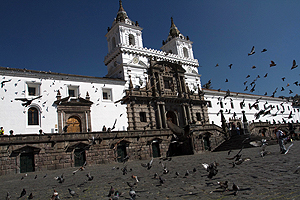 Quito, the metropolitan capital of Ecuador, was founded on 6 December, 1534, by Sebestián de Benalcázar. Its importance is based upon the conservation of architectural projects from the colonial period, such as the churches of La Compañía, San Francisco, La Catedral, El Sagrario, La Merced, Santa Bárbara, San Agustín and many others, the majority of which house the works of famous artists such as Caspicara.
Quito, the metropolitan capital of Ecuador, was founded on 6 December, 1534, by Sebestián de Benalcázar. Its importance is based upon the conservation of architectural projects from the colonial period, such as the churches of La Compañía, San Francisco, La Catedral, El Sagrario, La Merced, Santa Bárbara, San Agustín and many others, the majority of which house the works of famous artists such as Caspicara.
Their facades are covered in metal leaf (schlagmetal) and most of them have a strategic location with respect to the path that the sun makes around the equator.
Furthermore, Spanish structures form well defined square blocks and narrow streets that form a grid containing houses with thick columns, courtyards, high roofs and balconies from which serenades could be heard.
There are a variety of museums, in the colonial part and the modern part of Quito, which contain valuable works of art from the 16th, 17th and 18th centuries. These features gave it the title of first city to be named a UNESCO World Cultural Heritage site, in 1978.
Legends, stories, tales and characters can be added to this tangible heritage that shaped life in Quito throughout different periods, including: Atahualpa, Rumiñahui, Cantuña, Eugenio de Santa Cruz y Espejo, La torera, la pequeña Aurora, el Gallito de la Catedral , Manuela Cañizares, José Mejía Lequerica, Manuelita Saenz (names left in original Spanish form).
MITAD DEL MUNDO (MIDDLE OF THE WORLD)
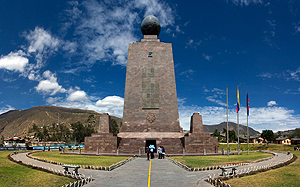 A group from France arrived in the country and, after several studies, found that the latitude marked 0 ° 0'0''. They wrote letters "from Equatore", meaning “from the middle”, hence the name Republic of Ecuador (1736). But hundreds of years before, the "Quitus" had already drawn this conclusion because of their close relationship with the sun and its movements, which they called Intiñan, meaning “path of the sun”. There is now a monument that reminds us of the imaginary division of the Earth into two hemispheres. To the delight of local and foreign tourists, the local government of the province of Pichincha organizes cultural events on every weekend and holiday. These reflect the cultural diversity that exists in Ecuador and the characteristic activities of the country’s mixed cultures, such as bullfighting and cockfighting.
A group from France arrived in the country and, after several studies, found that the latitude marked 0 ° 0'0''. They wrote letters "from Equatore", meaning “from the middle”, hence the name Republic of Ecuador (1736). But hundreds of years before, the "Quitus" had already drawn this conclusion because of their close relationship with the sun and its movements, which they called Intiñan, meaning “path of the sun”. There is now a monument that reminds us of the imaginary division of the Earth into two hemispheres. To the delight of local and foreign tourists, the local government of the province of Pichincha organizes cultural events on every weekend and holiday. These reflect the cultural diversity that exists in Ecuador and the characteristic activities of the country’s mixed cultures, such as bullfighting and cockfighting.
VALLE DE LOS CHILLOS (CHILLOS VALLEY)
A wonderful climate combined with the warmth of its people, history, traditions, culture and unique gastronomy make the Chillos Valley the ideal place for family recreation, adventure tourism, community experiences, ecotourism, fun and relaxation, which, combined with a rural setting, awaken a rewarding feeling in those who visit that always invites them back. This is also due to a varied topography ranging from 2500 meters to the Pintag Summit at 3900 meters, which has given rise to a variety of flora, fauna and unique landscapes in the country.
The Chillos Valley is located southeast of the province of Pichincha, just 20 minutes from downtown Quito.
NORTHWEST OF QUITO
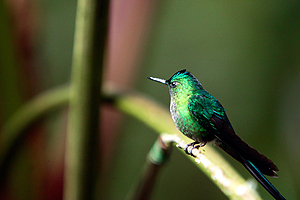 The parishes that form the northwest of Quito are Nanegalito, Nanegal, Nono, Gualea and Covenant. Their humid and rainy, but at the same time hot, climate produces a variety of plants such as guava, cinnamon, bay leaf and the delicious cane from which distilled spirits and panela are produced. The diversity of animals is no less amazing, with butterflies and birds being the biggest attraction. Together they form a natural paradise in which forests, waterfalls, cultures, crafts and parties can be enjoyed, with a commitment to care for them for future generations.
The parishes that form the northwest of Quito are Nanegalito, Nanegal, Nono, Gualea and Covenant. Their humid and rainy, but at the same time hot, climate produces a variety of plants such as guava, cinnamon, bay leaf and the delicious cane from which distilled spirits and panela are produced. The diversity of animals is no less amazing, with butterflies and birds being the biggest attraction. Together they form a natural paradise in which forests, waterfalls, cultures, crafts and parties can be enjoyed, with a commitment to care for them for future generations.
CALDERON
The Guanguiltagua plateau is home to the Calderon and Llano Chico communities; many people have chosen this place to live thanks to its temperate and dry climate, suitable for recovering from illnesses acquired in damp places.
Some of Calderon’s main cultural features have carried on, such as the celebration of the Day of the Dead on 2 November and the elaboration of hand-crafted marzipan and carved wooden furniture, all of which have transcended the passing of the years and the region’s population growth.
This urban development began in 1930, with the construction of the North Panamerican Highway that divides the population of Calderon into two, the road that is now the main access route to this site and the centre of Quito. It also connects to the centre of Quito through the Simon Bolivar roadway and the new route to the airport.
SANGOLQUI
Sangolquí, land of corn and tourism, is one of the destinations of choice for people from the capital city because of its warm climate and proximity, not to mention the local delicacies of tortillas with hornado (roasted pork), mote (large, white corn), tostado (roasted corn) and chicha (beverage made of fermented grains). These provide sufficient reasons to visit this county but are not the only ones; there are many nearby sites with waterfalls, parks, rivers, monuments and handicrafts that make this a cosy place to enjoy a weekend.
MACHACHI
Surrounded by mountains, its prosperous lands are dedicated to agriculture and livestock. However, there are many other attractions that are frequented by tourists, such as el Pasochoa, el Sincholagua and el Rumiñahui, as well as hot springs and colourful markets full of vegetables, grains, animals and handicrafts.
COTOPAXI
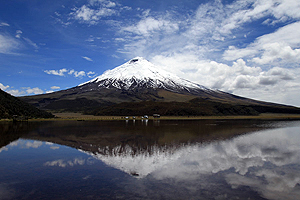 Situated in the Eastern Cordillera of the Andes, forming part of an area of 33393 hectares, Cotopaxi composes the oldest park in the country, declared as such in 1975, under the name Cotopaxi National Park.
Situated in the Eastern Cordillera of the Andes, forming part of an area of 33393 hectares, Cotopaxi composes the oldest park in the country, declared as such in 1975, under the name Cotopaxi National Park.
Cotopaxi is the symbol of Ecuador and one of the highest and most beautiful volcanoes in the world. Given the area’s wealth of fauna, flora and geomorphology, which starts at the base, with a humid tropical ecosystem, and ends at the cold climate of the summit, ecotourism, eager for this biodiversity, has found a good destination.
Limpiopungo Lagoon is a bird watching attraction, including the Andean Gull (Larus serranus), the only bird in the world found at this altitude.
You can also access the Rumiñahui, Quilindaña and Sincholagua Volcanoes.
The park is outfitted with an environmental interpretation centre and local guides, cabins for accommodation and the José Rivas refuge, located at 4800 metres.
LOJA
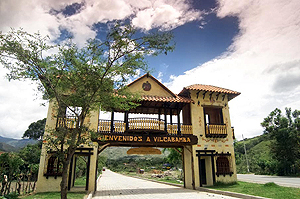 The capital of the southernmost province has won several international awards for being a touristic, social, economic and ecological reference for the country. It is also known for its grand potential as the Musical Capital of Ecuador and, above all, because of the urban regeneration that has occurred during the last few years.
The capital of the southernmost province has won several international awards for being a touristic, social, economic and ecological reference for the country. It is also known for its grand potential as the Musical Capital of Ecuador and, above all, because of the urban regeneration that has occurred during the last few years.
Loja is home to beautiful monuments and buildings such as Don Quixote and Sancho Panza, the gateway to the city that is a big castle, and several parks such as Jipiro, Reinaldo Espinoza and the Francisco Vivar Educational and Recreational Park, all with extensive green areas, trails, squares and small lakes, etc.
YASUNI NATIONAL PARK
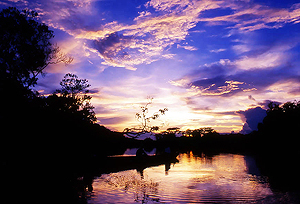 With 982000 hectares of tropical rainforest, it is one of the most important reserves in the world, declared as a UNESCO Biosphere Reserve due to its high levels of biodiversity. It covers the Napo River basins (south), Yasuní Tiputini Nashiño, Curaray Cononaco and tributaries. Quichua peoples inhabit the north and the legendary Huaorani inhabit the south-central region. There are important biological stations located there, such as those of the University of San Francisco (Tiputini River) and the Catholic University. Currently, this area is considered as a symbol of a commitment to conservation and nature because underneath its soil there are 846 million barrels of oil that are expected to indefinitely remain underground, if all the world's peoples are to compensate Ecuador for this initiative.
With 982000 hectares of tropical rainforest, it is one of the most important reserves in the world, declared as a UNESCO Biosphere Reserve due to its high levels of biodiversity. It covers the Napo River basins (south), Yasuní Tiputini Nashiño, Curaray Cononaco and tributaries. Quichua peoples inhabit the north and the legendary Huaorani inhabit the south-central region. There are important biological stations located there, such as those of the University of San Francisco (Tiputini River) and the Catholic University. Currently, this area is considered as a symbol of a commitment to conservation and nature because underneath its soil there are 846 million barrels of oil that are expected to indefinitely remain underground, if all the world's peoples are to compensate Ecuador for this initiative.
CUYABENO RESERVE
 It is comprised of spectacular lake systems and biologically rich tropical rainforest; it is flooded, but accessible, in the rainy season. In this area you can see manatees, pink dolphins, alligators, monkeys of many species and a variety of birds. There are lodging facilities in hostels and cottages next to the big lake.
It is comprised of spectacular lake systems and biologically rich tropical rainforest; it is flooded, but accessible, in the rainy season. In this area you can see manatees, pink dolphins, alligators, monkeys of many species and a variety of birds. There are lodging facilities in hostels and cottages next to the big lake.
TENA
One of the most welcoming communities in the Ecuadorian Amazon is, undoubtedly, Tena. It has a large tourism infrastructure and the most interesting attractions for those seeking adventure.
There are zoos and rescue centres where the variety of wildlife that exists in the sector can be seen.
You can also take a boat trip on the nearby rivers, kayak with professional staff and visit the local communities with whom worldview, customs and traditions are shared through community tourism.
PUYO
A beautiful city located in the Amazon, it is the starting point for great adventures in the biodiversity awaiting you in the province of Pastaza. The Puyo River constitutes one of the most important attractions, but the flora and fauna that can be seen in rescue centres, museums and zoos will make your stay unforgettable.
ISLAS GALÁPAGOS
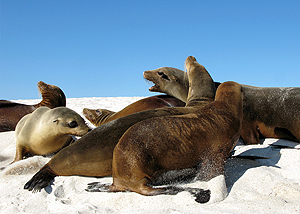 Discovered by Fray Tomas de Berlanga in 1535, the volcanic Galapagos Islands are located 965 kilometres west of the Ecuadorian coast. The islands have fascinated scientists since Charles Darwin’s visit in 1835. In 1959, it was declared a National Park. This same year, the Charles Darwin Station was established because of the park’s scientific importance.
Discovered by Fray Tomas de Berlanga in 1535, the volcanic Galapagos Islands are located 965 kilometres west of the Ecuadorian coast. The islands have fascinated scientists since Charles Darwin’s visit in 1835. In 1959, it was declared a National Park. This same year, the Charles Darwin Station was established because of the park’s scientific importance.
The archipelago consists of 13 major islands, 17 islets and dozens of rocks. The climate varies from temperate to warm, with temperatures ranging from 18 to 22 degrees Celsius.
Undoubtedly, the most prominent attraction of the islands are their animals, such as sea lions, boobies, iguanas, frigate birds and penguins, not to mention the giant tortoises that give the name to the islands. Under the sea, there is an infinite variety of fish, coral, and other marine animals that can be seen while diving.
There are several trails and tours that allow tourists to visit beaches, volcanoes, rock formations and the places where these unique species, that seem to have stopped in time, live. For more information, see your travel agent.
GUAYAQUIL (CIUDAD DE SANTIAGO DE GUAYAQUIL)
 It was founded at the foot of the Santa Ana Hill, one of the city’s most visited sites because of the beautiful view seen from the summit, where there are some guns that were used centuries ago to defend against pirate attacks. The houses were built at different levels, as was the Spanish custom. Archaeological remains of several pre-Columbian cultures such as Valdivia, Machalilla, Chorrera and Manteña Guangala were also found. The gulf, rivers, churches, museums and parks are important attractions of the port city, not to mention its vibrant nightlife and trade. You can also visit the boardwalk and tour the city by bus, as well as visit shopping malls. If you want to go a little further away from the city, visiting the zoo or the church of Narcisa de Jesus is recommended. The beaches near Guayaquil such as Salinas and Villamil are another attraction that should not be missed.
It was founded at the foot of the Santa Ana Hill, one of the city’s most visited sites because of the beautiful view seen from the summit, where there are some guns that were used centuries ago to defend against pirate attacks. The houses were built at different levels, as was the Spanish custom. Archaeological remains of several pre-Columbian cultures such as Valdivia, Machalilla, Chorrera and Manteña Guangala were also found. The gulf, rivers, churches, museums and parks are important attractions of the port city, not to mention its vibrant nightlife and trade. You can also visit the boardwalk and tour the city by bus, as well as visit shopping malls. If you want to go a little further away from the city, visiting the zoo or the church of Narcisa de Jesus is recommended. The beaches near Guayaquil such as Salinas and Villamil are another attraction that should not be missed.
LAS PEÑAS
A long staircase surrounded by beautiful houses, lights and craft shops makes Las Peñas an ideal place to visit in Guayaquil, an attraction best visited at night. You have a variety of spaces at your disposal where the local cuisine can be enjoyed and where you can imagine the pirate attacks of earlier centuries. From atop a huge lighthouse you can admire the beautiful and great city that stretches out below you on the River Guayas. If you visit Guayaquil, do not forget to enjoy a moment of fun in Las Peñas.
PEDERNALES
Pedernales’ beautiful beaches are within a few hours’ drive from Quito, providing the opportunity to enjoy its warm waters and magnificent waves.
There is a tourism infrastructure that facilitates an enjoyable experience without any major concerns.
BAHÍA DE CARAQUEZ
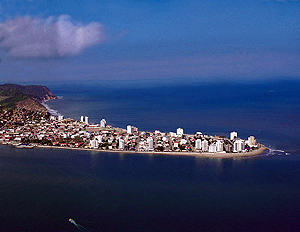 Bahía is not only a beautiful and safe city with spectacular beaches, but it also boasts mangroves, tropical dry forests and archaeological sites that provide visitors with extensive options.
Bahía is not only a beautiful and safe city with spectacular beaches, but it also boasts mangroves, tropical dry forests and archaeological sites that provide visitors with extensive options.
You can go kayaking, surfing, windsurfing and whale watching (between June and September), as well as visit the Heart Island Wildlife Refuge, where there are more than 100 species of birds.
The nearby beaches of San Jacinto, San Clemente and Charapoto have beautiful and clean pools.
MACHALILLA
This park that aims to protect tropical dry forest is the ideal place to have an intimate encounter with nature. Idyllic beaches, forests, archaeological sites and mischievous animals make Machalilla an unforgettable place.
Between June and September, you can watch the whales that come from the Antarctic and perform dances to find a partner and have children on the warm sand beaches. The visit can be complemented with a trip to Isla de la Plata (Silver Island), where there are blue-footed boobies and frigate birds.
In the forest, there are deer, monkeys, pumas, anteaters and hundreds of birds. You can go snorkelling off the islands’ shores to see coral reefs.
ZARUMA
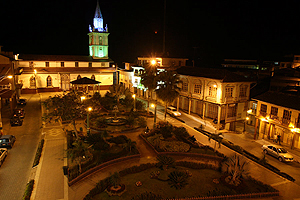 The gold that was mined from the mountain was this beautiful town’s engine of growth.
The gold that was mined from the mountain was this beautiful town’s engine of growth.
Spanish architecture left its legacy, visible in the houses with balconies and large windows now converted into shops and trading posts.
As a result of its narrow streets and well-preserved architecture, it was declared as a National Heritage site of Ecuador. But that's not all its appeal, as the surrounding hills make it possible to obtain beautiful views of nature as well.
OTAVALO
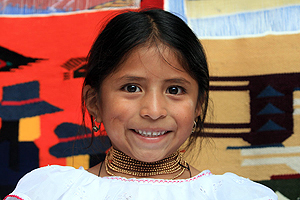 Otavalo is both nationally and internationally recognized for its Saturday market, which takes place in the Centenary Market, now known as Plaza de los Ponchos. The market is attended by over one thousand craftsmen and traders, which is why it is considered the largest craft market in Latin America.
Otavalo is both nationally and internationally recognized for its Saturday market, which takes place in the Centenary Market, now known as Plaza de los Ponchos. The market is attended by over one thousand craftsmen and traders, which is why it is considered the largest craft market in Latin America.
The largest market is held every Saturday, though there are daily markets. Currently, the market is a place where cultures come together. Here you will find paintings from Tigua communities, tapestries from Salasacas communities, carvings from San Antonio de Ibarra, leather goods from Cotacachi, handicrafts from Saraguros communities and Kichwa communities from the east, as well as countries such as Peru and Bolivia. Otavalo is, today, considered a cultural front.
You can find traditional handicrafts from Otavalo that, although designs, raw materials and quality have changed, still reflect the thinking and worldview of its people.
CUENCA
 Cuenca, a UNESCO World Cultural Heritage site, proudly carries this title thanks to the conservation of its colonial architecture, dating from the 18th century, lining the four rivers that cross the valley: Tomebamba, Yanuncay, Tarqui and Machángara. Among the sites to be visited are: the Cathedral, the church of Conceptas, Santo Domingo, the Calderon Park, Plaza de las Flores (Flower Plaza), the Forges neighbourhood and the Museum of the Central Bank. There are several stores that sell handicrafts from the city and surrounding areas. In terms of cuisine, the city’s best known dish is the mote pillo (white corn scrambled with eggs).
Cuenca, a UNESCO World Cultural Heritage site, proudly carries this title thanks to the conservation of its colonial architecture, dating from the 18th century, lining the four rivers that cross the valley: Tomebamba, Yanuncay, Tarqui and Machángara. Among the sites to be visited are: the Cathedral, the church of Conceptas, Santo Domingo, the Calderon Park, Plaza de las Flores (Flower Plaza), the Forges neighbourhood and the Museum of the Central Bank. There are several stores that sell handicrafts from the city and surrounding areas. In terms of cuisine, the city’s best known dish is the mote pillo (white corn scrambled with eggs).
QUILOTOA LAGOON
A turquoise lake located in the centre of the crater of the active Quilatoa Volcano has, itself, become a visitor attraction. The nature calms you, while the wind accompanies you on your walk around the crater.
In the nearby Zumbahua area, inns offer guided tours.
The descent to the lake takes 30 minutes and the ascent takes one hour. You can hike around the lake and between Quilotoa and Chugchilán (5 hours approx.). Mules can be rented and there are also mountain biking paths.
BAÑOS DE AGUA SANTA
Baños is located between the Tungurahua Volcano and the Pastaza River, 40 kilometres from the city of Ambato.
Baños has unique a landscape of forests and mountains, waterfalls and hot springs. It is one of the most popular tourist destinations in Ecuador.
It is a small town with a lot of movement, where you can hike (trekking), bird watch, bike (downhill to Puyo, in the Amazon), climb, as well as participate in white water rafting and other adventure sports. There are also several public pools, which include Piscinas Modernas, Baños de la Virgen, El Salado, Santa Ana and Santa Clara, as well as hotels with private pools. In Baños you can taste the area’s famous taffy and sugar figurines, cane juice and other local goodies. On the road to Puyo, there are waterfalls, bridges, tarabitas (zip lining in an open cage) and lots of wildlife.
Baños is a city where indigenous traditions and customs mix with those of foreign visitors.

















